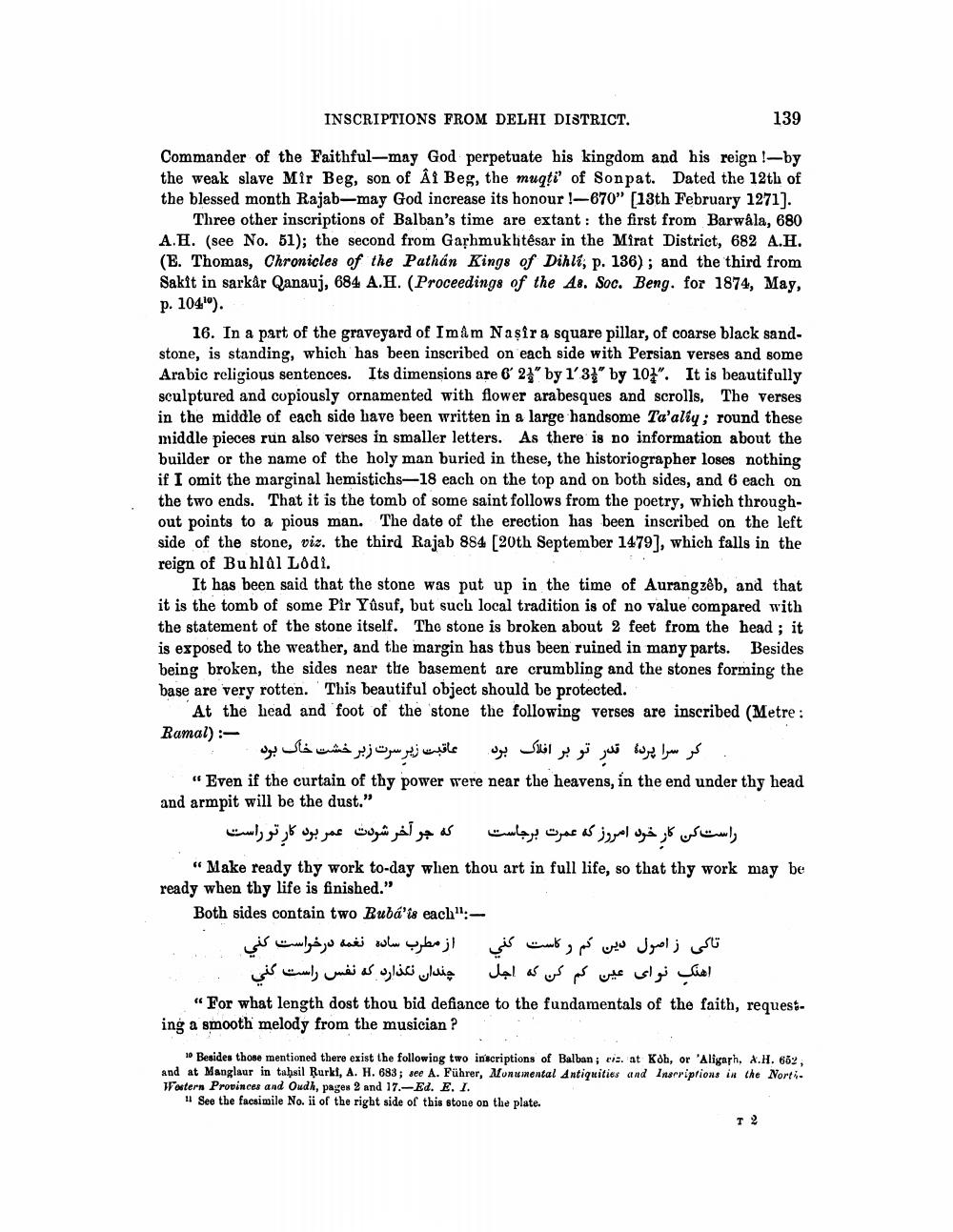________________
INSCRIPTIONS FROM DELHI DISTRICT.
Commander of the Faithful-may God perpetuate his kingdom and his reign!-by the weak slave Mir Beg, son of Ai Beg, the mugti' of Sonpat. Dated the 12th of the blessed month Rajab-may God increase its honour!-670" [13th February 1271].
Three other inscriptions of Balban's time are extant: the first from Barwala, 680 A.H. (see No. 51); the second from Garhmukhtêsar in the Mirat District, 682 A.H. (E. Thomas, Chronicles of the Pathan Kings of Dihli, p. 136); and the third from Sakit in sarkâr Qanauj, 684 A.H. (Proceedings of the A8. Soc. Beng. for 1874, May, p. 104).
16. In a part of the graveyard of Imam Nasir a square pillar, of coarse black sandstone, is standing, which has been inscribed on each side with Persian verses and some Arabic religious sentences. Its dimensions are 6′ 23′′ by 1'3" by 101". It is beautifully sculptured and copiously ornamented with flower arabesques and scrolls, The verses in the middle of each side have been written in a large handsome Ta'aliy; round these middle pieces run also verses in smaller letters. As there is no information about the builder or the name of the holy man buried in these, the historiographer loses nothing if I omit the marginal hemistichs-18 each on the top and on both sides, and 6 each on the two ends. That it is the tomb of some saint follows from the poetry, which throughout points to a pious man. The date of the erection has been inscribed on the left side of the stone, viz. the third Rajab 884 [20th September 1479], which falls in the reign of Buhlûl Lôdi.
It has been said that the stone was put up in the time of Aurangzeb, and that it is the tomb of some Pir Yûsuf, but such local tradition is of no value compared with the statement of the stone itself. The stone is broken about 2 feet from the head; it is exposed to the weather, and the margin has thus been ruined in many parts. Besides being broken, the sides near the basement are crumbling and the stones forming the base are very rotten. This beautiful object should be protected.
At the head and foot of the stone the following verses are inscribed (Metre : Ramal):
عاقبته زیر سرت زیر خشت خاک بود کر سرا پرده قدر تو بر افلاک بود
139
"Even if the curtain of thy power were near the heavens, in the end under thy head and armpit will be the dust."
که در آخر شودن عمر برد کار تو راست راست کی کار خود امروز که عمرت برجاست
"Make ready thy work to-day when thou art in full life, so that thy work may be ready when thy life is finished."
Both sides contain two Bubá'is each11:
از مطرب ساده نغمه درخواست کنی تاکی زاصول دین کم و کاست كني
چندان نگذارد که نفس راست کلی اهنگ نوای عین کم کن که اجل
"For what length dost thou bid defiance to the fundamentals of the faith, requesting a smooth melody from the musician?
10 Besides those mentioned there exist the following two inscriptions of Balban; eiz. at Koh, or 'Aligarh, A.H. 652, and at Manglaur in tahsil Rurki, A. H. 683; see A. Führer, Monumental Antiquities and Inscriptions in the NorthWestern Provinces and Oudh, pages 2 and 17.-Ed. E. I.
See the facsimile No. ii of the right side of this stone on the plate.
T 2




